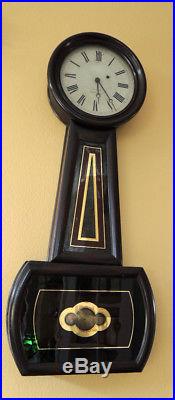
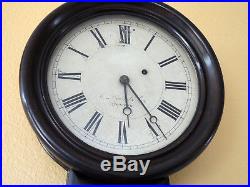
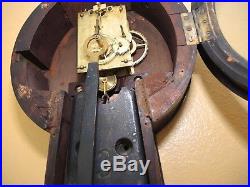
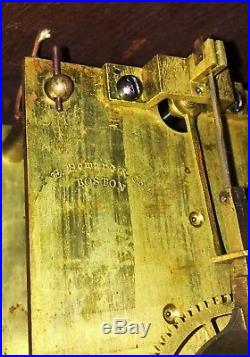
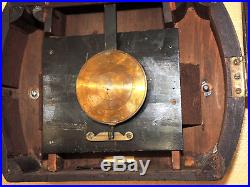
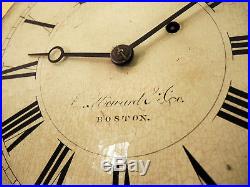
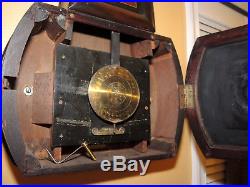
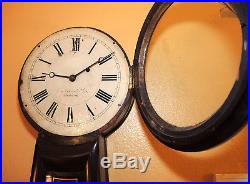
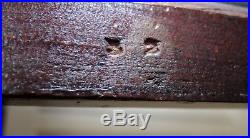
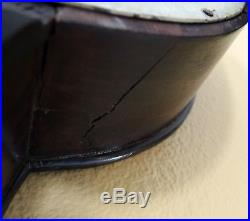
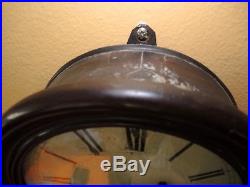


His is the much sought after. It belonged to my great, great aunt who lived in St. I brought it with me when I moved to South Florida, Approximately 12 years ago a clock expert picked it up taking to his shop and brought it back working beautifully. Kept perfect time for almost 6 years. That had to be in perfect balance to run properly and bolted to wall to keep it in place. I know very little (if anything) about clocks of this type and will do my best to answer any questions. Height is 38″ x 16″ wide, depth is 4 1/4. Condition as shown in photos; last 3 indicate cracks in the wood. There is the number 32. On wood opposite lower panel (photo). The plate behind the brass pendulum has a few holes and one nail out. Howard, Boston , some surface cracks. On the left side of the movement is E. I live outside Stuart Florida. Louis mid August if you are on the way! First patented in 1802 by brothers Aaron and. Was one of the most popular clocks of its time. Despite the patent, it didnt take long for other clockmakers to jump on the bandwagon and copy the Willards design. Unfortunately for collectors of antique banjo clocks, many Willard banjo clocks do not carry their makers name, so it is often difficult to identify who made it. Originally called an “Improved Timepiece, ” the. Later became known as a. Because it looked similar to the musical instrument. Its white, circular face, painted with black numbers (mostly Roman numerals), flows into a long, tapered neck, which meets at a square base. The hinged door of the base is elaborately painted, often with a beautiful view, a naval scene, or an ornamental pattern. Thin pieces of curved brass often run down the necks of these clocks, and brass sculptures, most commonly of an eagle, routinely crown their tops. Howard, a clock making apprentice of Aaron Willard, Jr. Had commenced business with David P. Davis, manufacturing high-grade wall clocks under the name of Howard & Davis in 1842. They also became known for their manufacture of sewing machines, fire engines and precision balances. About 1843, with a third partner, Luther Stephenson, they began to also manufacture tower clocks. In 1857, David P. Davis left the firm and Howard & Davis was dissolved and was succeeded by E. Both Howard and Davis had also been involved in watch manufacturing, somewhat unsuccessfully, since 1850, In 1857, Edward Howard began a new watch company and on March 24, 1861 combined his clock and watch businesses into one joint stock corporation, the Howard Clock & Watch Company, which failed in 1863. Thereafter, Howard formed a new company called the Howard Watch & Clock Company (transposing clock & watch) on October 1, 1863, which was successful for some years but was reorganized in 1881 after financial setbacks. This firm continued the manufacture of many clock styles, primarily weight driven wall timepieces and regulators of fine quality. Only a couple common wall models, #5 and # 10, were produced as stock items, all others being manufactured by special order. Clocks were manufactured at Roxbury, a part of Boston, but in the early 1930’s the operation was moved to Waltham, MA. A new firm known as Howard Clock Products was formed November 5, 1934 to succeed the earlier firm. Clock production was on the wane, but precision gear cutting business kept the firm profitable, particularly from government contract work. Production of smaller clocks ceased in 1957 or 1958 and the last tower clock was produced in 1964. However, in 1975, Dana J. Blackwell, as a new Vice President of the firm, revived clock production, reintroducing several of the more popular models to the market. Movements in these later clocks maintained the high standards the Howard firm had become famous for and cases were made to very strict specifications. Beckman eventually fired most of the firm’s knowledgeable management and proceeded to drain it financially. By 1980, when the firm was at the verge of bankruptcy, Beckman was caught with a bunch of hired thugs in an attempt to blow up the factory building. After a lengthy trial he was convicted, though never served any time in jail. At the time of Beckman’s arrest, the Federal Government stepped in and the Howard firm was placed under Chapter 11 of the bankruptcy code. The item “E HOWARD & CO. Boston BANJO Clock #3 Regulator stamped #32 c1870 NICE” is in sale since Friday, July 13, 2018. This item is in the category “Collectibles\Clocks\Antique (Pre-1930)\Wall”. The seller is “rintintinantiques” and is located in Palm City, Florida. This item can be shipped to United States.
- Country/Region of Manufacture: United States
- Brand: E. Howard & Sons
- Clock Type: Banjo
